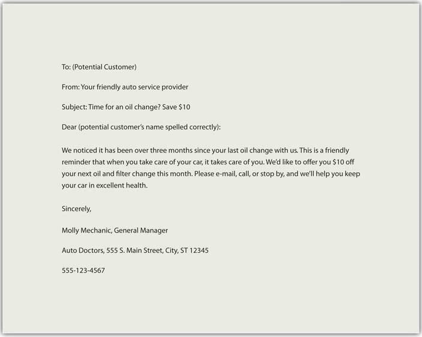Learning Objectives
Discuss a basic sales message and identify its central purpose.
Detail the main parts of a sales message and understand strategies for success.
A sales message is the central persuasive message that intrigues, informs, persuades, calls to action, and closes the sale. Not every sales message will result in a direct sale, but the goal remains the same. Whether your sales message is embedded in a letter, represented in a proposal, or broadcast across radio or television, the purpose stays the same.
Sales messages are often discussed in terms of reason versus emotion. Every message has elements of ethos, or credibility; pathos, or passion and enthusiasm; and logos, or logic and reason. If your sales message focuses exclusively on reason with cold, hard facts and nothing but the facts, you may appeal to some audience, but certainly not the majority. Buyers make purchase decisions on emotion and reason, and even if they have researched all the relevant facts about competing products, the decision may still come down to impulse, emotion, and desire. If your sales message focuses exclusively on emotion, with little or no substance, it may not be taken seriously. Finally, if your sales message does not appear to have credibility, the message will be dismissed. In the case of the sales message, you need to meet the audience’s varying needs.
In general, appeals to emotion pique curiosity and get our attention, but some attention should also be paid to reason and facts. That doesn’t mean we need to spell out the technical manual on the product in the opening sale message, but basic information about design or features, in specific, concrete ways, can help an audience make sense of your message and the product or service. Avoid using too many abstract terms or references, as not everyone will understand these. You want your sales message to do the work, not the audience.
Format for a Common Sales Message
A sales message has the five main parts of any persuasive message.

Getting Attention
Your sales message will compete with hundreds of other messages, and you want it to stand out (Price, D., 2005). One effective way to do that is to ensure your attention statement(s) and introduction clearly state how the reader or listener will benefit.
- Will the product or service save time or money?
- Will it make them look good?
- Will it entertain them?
- Will it satisfy them?
Regardless of the product or service, the audience is going to consider first what is in it for them. A benefit is what the buyer gains with the purchase and is central to your sales message. They may gain social status, popularity, sex appeal, or even reduce or eliminate something they don’t want. Your sales message should clearly communicate the benefits of your product or service (Winston, W., and Granat, J., 1997).
Sales Message Strategies for Success
Your product or service may sell itself, but if you require a sales message, you may want to consider these strategies for success:
- Start with your greatest benefit. Use it in the headline, subject line, caption, or attention statement. Audiences tend to remember the information from the beginning and end of a message but have less recall about the middle points. Make your first step count by highlighting the best feature first.
- Take baby steps. One thing at a time. Promote, inform, and persuade on one product or service at a time. You want to hear “yes” and make the associated sale, and if you confuse the audience with too much information, too many options, steps to consider, or related products or services, you are more likely to hear “no” as a defensive response as the buyer tries not to make a mistake. Avoid confusion and keep it simple.
- Know your audience. The more background research you can do on your buyer, the better you can anticipate their specific wants and needs and individualize your sales message to meet them.
- Lead with emotion, follow with reason. Gain the audience’s attention with drama, humor, or novelty and follow with specific facts that establish your credibility, provide more information about the product or service, and lead to your call to action to make the sale.
These four steps can help improve your sales message and your sales. Invest your time in planning and preparation, and consider the audience’s needs as you prepare your sales message.

Key Takeaway
A sales message combines emotion and reason and reinforces credibility to create interest in a product or service that leads to a sale.
Exercises
Create your own e-mail sales message in a hundred words or less. Share it with the class.
Identify one sales message you consider to be effective. Share it with classmates and discuss why you perceive it to be effective.
Please consider one purchase you made recently. What motivated you to buy, and why did you choose to complete the purchase? Share the results with your classmates.
Price, D. (2005, October 30). How to communicate your sales message so buyers take action now! Retrieved June 14, 2009, from ezinearticles.com: http://ezinearticles.com/?How-To-Communicate-Your-Sales-Message-So-Buyers-Take-ActionNow!&id=89569.
Winston, W., & Granat, J. (1997). Persuasive advertising for entrepreneurs and small business owners: How to create more effective sales messages. New York, NY: Routledge.
This page titled 9.6: Sales Message is shared under a CC BY-NC-SA 3.0 license and was authored, remixed, and/or curated by Anonymous (LibreTexts Staff), from which source content was edited to the style and standards of the Pressbook platform licensed under a Creative Commons Attribution-NonCommercial-ShareAlike 4.0 International License by Brandi Schur.

